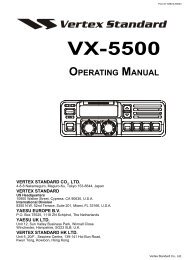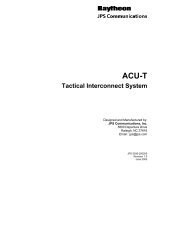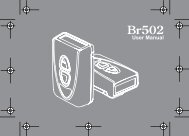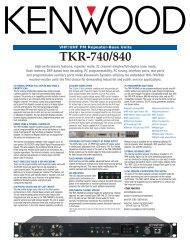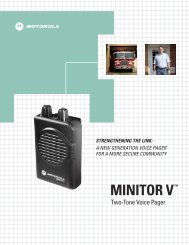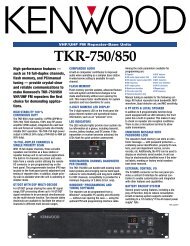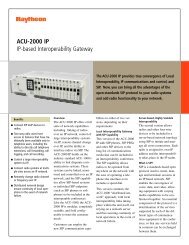DISTRIBUTED LOGIC TRUNKED RADIO SYSTEMS - Lauttamus ...
DISTRIBUTED LOGIC TRUNKED RADIO SYSTEMS - Lauttamus ...
DISTRIBUTED LOGIC TRUNKED RADIO SYSTEMS - Lauttamus ...
You also want an ePaper? Increase the reach of your titles
YUMPU automatically turns print PDFs into web optimized ePapers that Google loves.
2General:This paper has two purposes: First, it describes the fundamental concepts of modernanalog Trunked Radio Systems, their features and differences compared to conventionalradio systems and it provides some guidelines for maximizing a trunked radio system’sperformance. This fundamental information is intended for non-radio professionals, thosepersons with administrative or technical management backgrounds.Second, this paper goes into detail explaining the functional and technical aspects of theDistributed Logic approach used by Kenwood in designing and constructing trunked radiosystems. This detailed technical information, specifically intended for radio professionals,describes the system logic and the operation of the trunked system and subscriber units.Many system-specific features are available to customize a system or to create wide areanetworks. For additional information or system design assistance, call Kenwood U.S.A.Corp. – Communications Division at 1-800-TRUNKING (or 678-474-4700).Trunked Radio Systems, an Overview:In conventional radio systems, a group of mobiles occupies a single radio channel.When units need to communicate, this single channel carries their traffic. This channelusually remains idle for many hours each day with only a few minutes of actual traffictime.To use this single channel more efficiently, unrelated groups of users often share aconventional channel. Although several groups of users can usually co-exist on thesame channel, as their numbers increase so do interference and contention betweenunits. In practice, only a small number of user groups can be assigned to eachconventional channel before contention renders the channel useless. Since eachchannel still has significant idle periods, a conventional radio system is a very inefficientuse of the channel’s possible airtime, even when heavily loaded. There is no privacy inconventional radio systems, since all users can hear all others as they monitor thechannel for traffic already in progress before transmitting (an FCC requirement intendedto minimize contention).To improve spectral efficiency by maximizing the use of available airtime, a means ofcoordinating many users onto a group of channels was developed. These users operateon a non-interfering basis in a ‘trunked’ architecture similar in concept to the PublicSwitched Telephone Network (PSTN). Using this concept, a mobile can be transparentlyassigned to any channel in a pool of idle channels for his traffic, remaining free ofinterference or contention with other users. This coordination of frequency-agile mobilesand intelligent repeater stations is a Trunked Radio System.The trunking concept is based on the probability that in a multi-channel system not allchannels will be in use at the same time.....and not all users will need to be transmittingat the same time. A mobile unit that is automatically informed of available repeaters (orinformed of which repeater is calling), then automatically switched to that channel, has amuch greater chance of obtaining a channel when needed (a greatly reduced probabilityof contention or call blocking). In this manner, a limited number of trunk channels canaccommodate a very large number of end users. Trunking allows easier communicationflow for the user while greatly increasing channel efficiency over conventional systems.One approach to trunking uses existing conventional repeaters. These systems’ controllogic depends on the subscriber units themselves, with the mobiles constantly scanningconventional repeaters for available traffic channels or for inbound calls. These systemsKENWOOD U.S.A. CORPORATION – COMMUNICATIONS DIVISION678-474-4700 voice 1-800-TRUNKING 678-474-4730 fax



